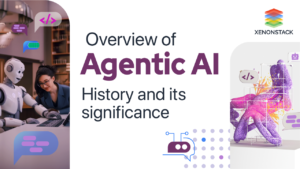Imagine a world where businesses operate at lightning speed, making decisions with uncanny precision
and delivering personalized experiences that seem almost magical. This isn’t science fiction—it’s the
reality of 2025, where Artificial Intelligence (AI) has become the driving force behind business
transformation.
From automating routine tasks to revolutionizing customer interactions, AI is reshaping industries at an
unprecedented pace. Yet, while 92% of employees are familiar with AI tools and eager to embrace them,
there’s a surprising disconnect: many leaders are struggling to keep up with this rapid evolution. The
question isn’t whether AI will change your business, but how quickly you’ll adapt to stay ahead of the
curve.
In this post, we’ll explore the game-changing applications of AI across various sectors, examine its
impact on workforce productivity, and uncover the challenges that come with this technological
revolution. We’ll also dive into strategies for successful AI implementation and peek into the future trends
that will define the business landscape. Whether you’re a C-suite executive or an ambitious professional,
understanding AI’s role in business is no longer optional—it’s essential for thriving in the AI-driven
economy of 2025 and beyond
The Evolution of AI in Business
A. From cost-reduction tool to strategic asset
Artificial Intelligence has undergone a significant transformation in its role within businesses. Initially
viewed primarily as a cost-reduction tool, AI has evolved into a strategic asset that drives innovation and
competitive advantage. According to a Slalom survey, 85% of C-suite executives plan to increase AI
spending in 2025, indicating the growing recognition of AI’s value in business transformation.
However, there’s a notable gap between understanding AI’s potential and implementing transformative
strategies:
- 71% of companies provide tools for AI utilization
- Only 39% offer essential mentoring and coaching
This disconnect limits AI’s transformative impact, highlighting the need for organizations to focus on:
- Building scalable AI solutions
- Empowering teams with necessary skills
- Continuously measuring AI initiative impacts
B. Shift in leadership focus: implementation to integration
Leadership perspectives on AI are evolving from mere implementation to comprehensive integration.
This shift is crucial for realizing AI’s full potential in driving business growth. Key aspects of this transition
include:
| Focus Area | Implementation Approach | Integration Approach |
|---|---|---|
| Strategy | Standalone AI projects | AI aligned with business goals |
| Training | Basic tool usage | Continuous learning and upskilling |
| Culture | Technology-centric | Innovation-driven |
| Measurement | Project-specific metrics | Holistic impact assessment |
Despite the urgency recognized by C-suite leaders, many organizations are lagging in execution. Nearly
half cite slow development and talent shortages as barriers to AI integration.
C. AI’s role in addressing global challenges
AI is increasingly positioned to tackle significant global issues, extending its impact beyond individual
businesses. The AI House forum at Davos 2025 highlighted the consensus among global leaders about
AI’s potential to influence society and the economy positively.
Key areas where AI is making a difference:
- Climate change mitigation
- Healthcare advancements
- Educational accessibility
- Economic equality
As AI continues to evolve, its capacity to address complex, large-scale challenges grows, making it an
essential tool for businesses aiming to contribute to global solutions while driving their own growth and
innovation.
With this understanding of AI’s evolution in business, we can now explore the specific ways in which AI is
being applied across various industries. In the next section, “Key Applications of AI in Business,” we’ll
delve into the concrete examples of how companies are leveraging AI to transform their operations and
create value.
Key Applications of AI in Business
Now that we have explored the evolution of AI in business, let’s delve into the key applications that are
transforming industries in 2025.
Process automation and efficiency enhancement
AI is revolutionizing business processes by automating repetitive tasks and enhancing efficiency.
According to recent data, 72% of organizations have implemented AI in at least one area by early 2024.
In the financial sector, 40% of executives reported using AI for task automation, with projections
indicating an increase to 54% in the coming year.
Key areas of process automation include:
- Customer service chatbots
- Applicant tracking systems in HR
- Automated accounting processes
These AI-driven tools not only boost productivity but also significantly reduce human error, allowing
businesses to allocate human resources to more complex, creative tasks.
Cognitive insights for data-driven decision making
AI’s ability to analyze vast amounts of data and provide actionable insights is transforming decisionmaking processes across industries. Businesses are leveraging AI for:
- Identifying market trends
- Optimizing pricing strategies
- Personalizing customer interactions
For instance, airlines are using predictive analytics to adjust ticket pricing based on demand patterns,
while marketing teams are harnessing AI for audience segmentation and enhanced market research.
Cognitive engagement for improved customer experiences
AI is revolutionizing customer engagement through personalized interactions and improved service
delivery. Some key applications include:
- Virtual health assistants in healthcare
- AI-powered recommendation engines in e-commerce
- Smart assistants for daily tasks
These AI-driven solutions are enhancing customer satisfaction by providing tailored experiences and
round-the-clock support
Personalization and predictive analytics
AI’s capabilities in personalization and predictive analytics are driving innovation across various sectors.
Here’s a comparison of AI applications in different industries:
| Industry | AI Application | Benefits |
|---|---|---|
| Healthcare | Personalized treatment plans | Improved patient outcomes |
| Retail | Customized shopping experiences | Increased customer loyalty |
| Finance | Fraud detection and risk assessment | Enhanced security and compliance |
| Education | Tailored learning experiences | Improved student engagement |
These applications demonstrate AI’s potential to create value by anticipating needs and delivering
customized solutions.
As we transition to the next section on AI’s impact on workforce and productivity, it’s clear that these key
applications are not only transforming business processes but also reshaping the nature of work itself.
The integration of AI across various business functions is setting the stage for significant changes in how
we approach tasks, make decisions, and interact with customers.




